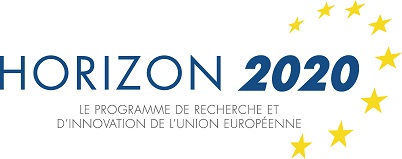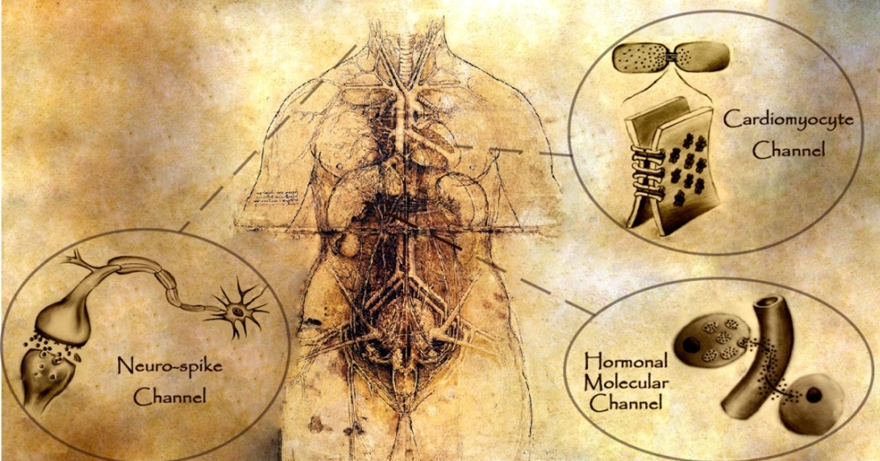|| Funded by: European Commission, H2020-FET-OPEN
|| Period: March 2015 - March 2017
|| Amount: 535.410 Euro |
  |
The theoretical and experimental basis of molecular communications involves a broad range of disciplines including ICT, Biology and Medicine. In essence this research field seeks to leverage biological phenomenon at the molecular level such as inter cell communication, usage of the immune system, bacterial DNA transfer, neuronal signalling and calcium signalling, to build a communications infrastructure for nano-scale devices that can be deployed and coordinate sophisticated operations within biological systems such as the human body. Among the plethora of envisaged disruptive applications, CIRCLE aims to leverage the heterogeneous expertise of the consortium to coorinate and support ongoing ambitious research objectives. An example of ongoing research activities that the CIRLCE consortium can support is the theoretical and experimental investigation into an intra-body sensor network enabling the networking together of advanced tumour treatment techniques for diseases like cancer. The combined detection and treatment techniques include circulating tumour cell (CTC) detection in the blood stream, injection of genetically modified bacteria into the tumour mass, real time monitoring of the tumour evolution and bacteria transcriptome, proteome, and concentration in time and body organs, thus leading to a plethora of highly disruptive treatment techniques to be developed. The main objectives of CIRCLE are as follows:

Objective 1: Harmonize heterogeneous islands of research in Molecular Communications across Europe by providing a structured research agenda through the collaborative specification and continual refinement of a research roadmap. |
Current research in the area of molecular communications is heterogeneous and dispersed across multiple disciplinary areas, with individual research groups pursuing their own strategic research agendas. To maximise European impact in this fledgling area of research, a well-established strategic research roadmap must be coordinated across the various Member States and harmonised with best practice internationally. CIRCLE will put in place a process for establishment and continual update of a Strategic Research Roadmap on Molecular Communications.
Objective 2: Stimulate guided learning for young researchers entering the area of Molecular Communications, through improving efficiency of knowledge acquisition in key disciplines. |
Molecular communications theory requires a unique set of skills that traverses ICT, Biology and Medicine. This knowledge is required to understand the biological processes of communications (BIO), information theory and communication protocol design (ICT), and experimental and theoretical validation within envisaged scenarios (Medicine). Currently ICT and Biology researchers wishing to enter this area of research face an inefficient process of acquiring the necessary skills set to effectively generate knowledge and impact in this area. To greatly improve the efficiency of entering this area for young researchers CIRCLE will put in place a process for the establishment and continually update of a Skills Development Plan for young researchers wishing to enter this highly interdisciplinary and unconventional topic of research. This will ensure Europe accelerates scientific advancements in the area of Molecular Communications and positions Europe at a competitive advantage in the future.
Objective 3: Build a structured community across Europe of research leaders and collaborators working in the area of Molecular Communication. |
Current research in the area of molecular communications is heterogeneous and dispersed across multiple disciplinary areas, with individual research groups pursuing their own strategic research agendas. To maximise European impact in this fledgling area of research, a well-established strategic research roadmap must be coordinated across the various Member States and harmonised with best practice internationally. CIRCLE will put in place a process for establishment and continual update of a Strategic Research Roadmap on Molecular Communications.

Objective 4: Accelerate the exchange of knowledge and best practice between researchers with Europe and internationally, focusing on Molecular Communications. |
To rapidly converge towards critical mass in the area of Molecular Communications research, the exchange of knowledge and best practice experimental procedures and methodologies is essential. CIIRCLE will put in place the necessary infrastructure and processes to enable shared access to lab equipment, sharing of code repositories and experimental data, quick dissemination of results, coordination of lab experiments, and exchange of experimental methodologies. This objective aims at stimulating learning by young researchers through collaboration and exchange of knowledge.
Objective 5: Facilitate a staff exchange program between partners within CIRCLE focusing in particular on young researchers. |
The best mechanism to stimulate learning of young researchers entering into a new area of research is to spend time working with experts in the area an learning best practice methodologies and knowledge, and having direct access to lab equipment and experimental data. Young researchers will be given the opportunity to spend a considerable amount of time in another hosting institute offering them the opportunity to extend their knowledge and capabilities in the area of molecular communications. Supporting visits between the different institutes within the consortium will also reinforce a structured collaborative research culture, which in turn will help promote and spread knowledge in this emerging area of research.
Objective 6: Reduce the barriers for entry into the area of Molecular Communications for high tech SME through the collaborative specification and continual refinement of an industry engagement roadmap. |
As the area of Molecular Communications still seems unconventional and high risk, there has yet to be any explicit and strategic interest from High Tech SMEs and entrepreneurs to get involved in this area. There are a number of barriers to entry that must be addressed for this research area to deliver disruptive technological achievements within the next 20 years. These include European policy, legal frameworks, patenting, licensing and other exploitation mechanism necessary for industry engagement. CIRCLE will engage with a wide range of stakeholders including policy makers, medical professionals, legal advisors and others through the election of targeted Expert Working groups and focused workshops, to tackle the major driving factors to ensure when the research is sufficiently mature that the frameworks are in place for European high tech SMEs to take advantage of this potentially game changing technology to develop novel solution for society.

